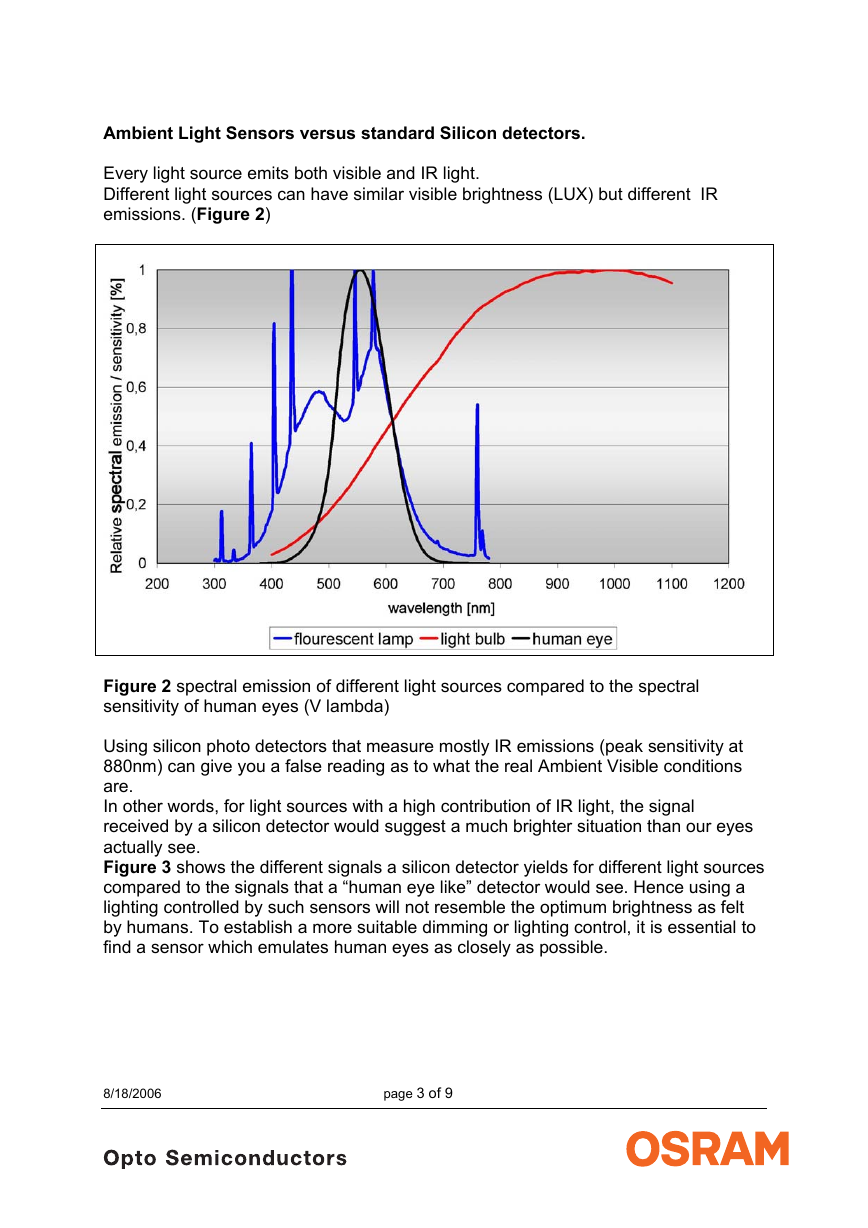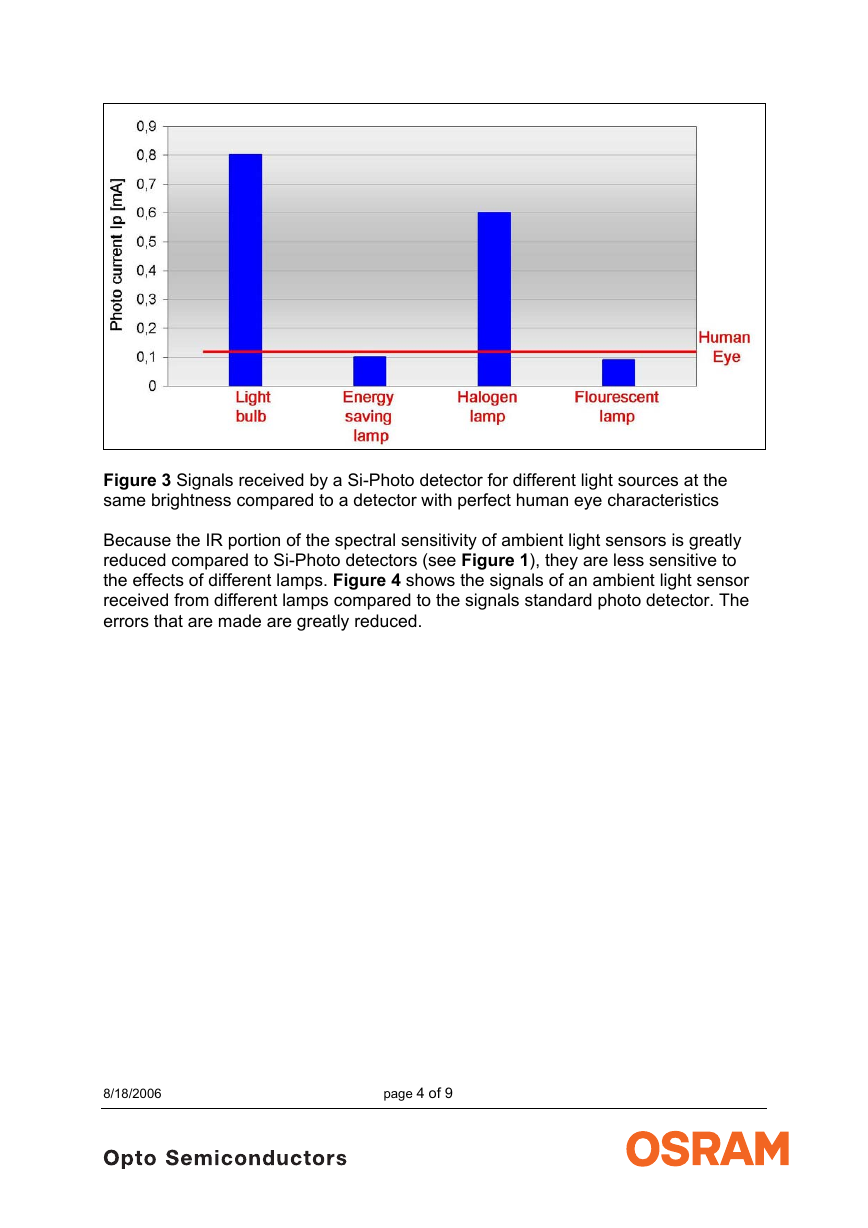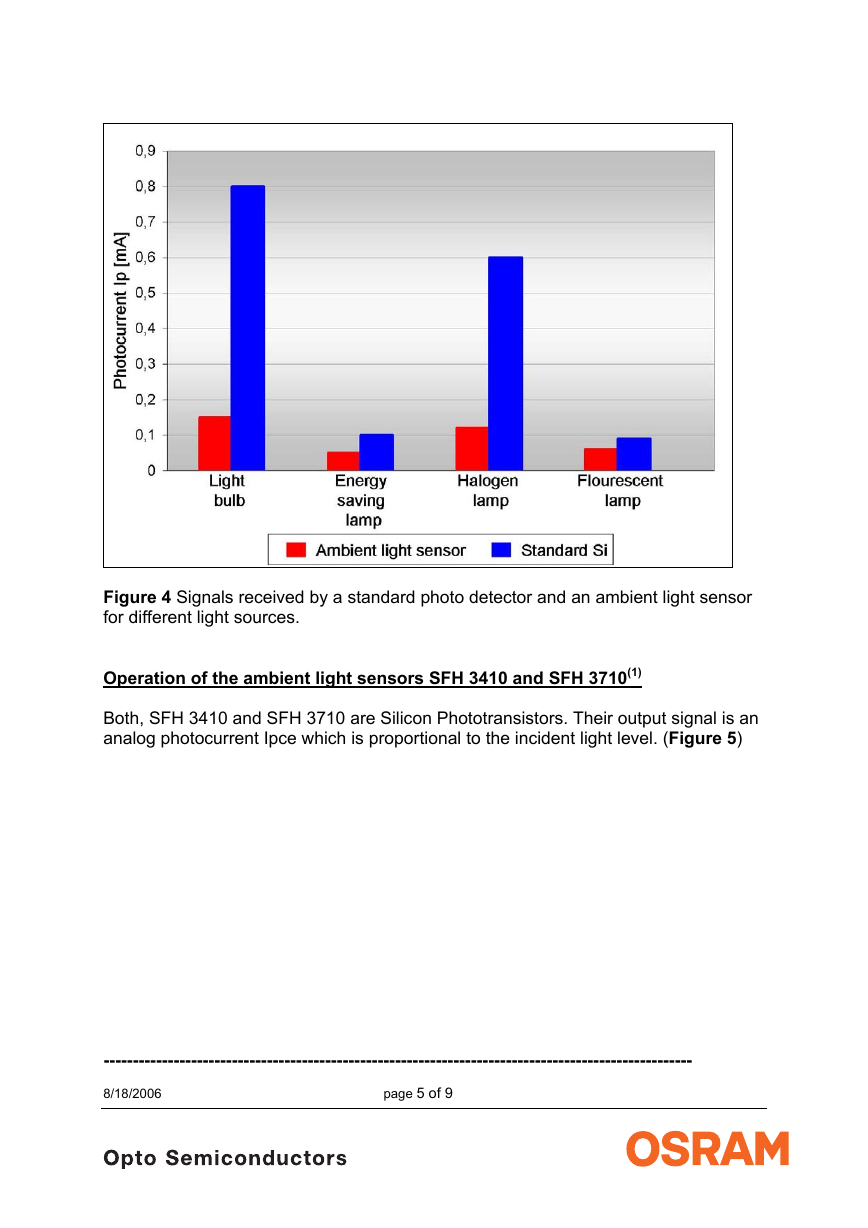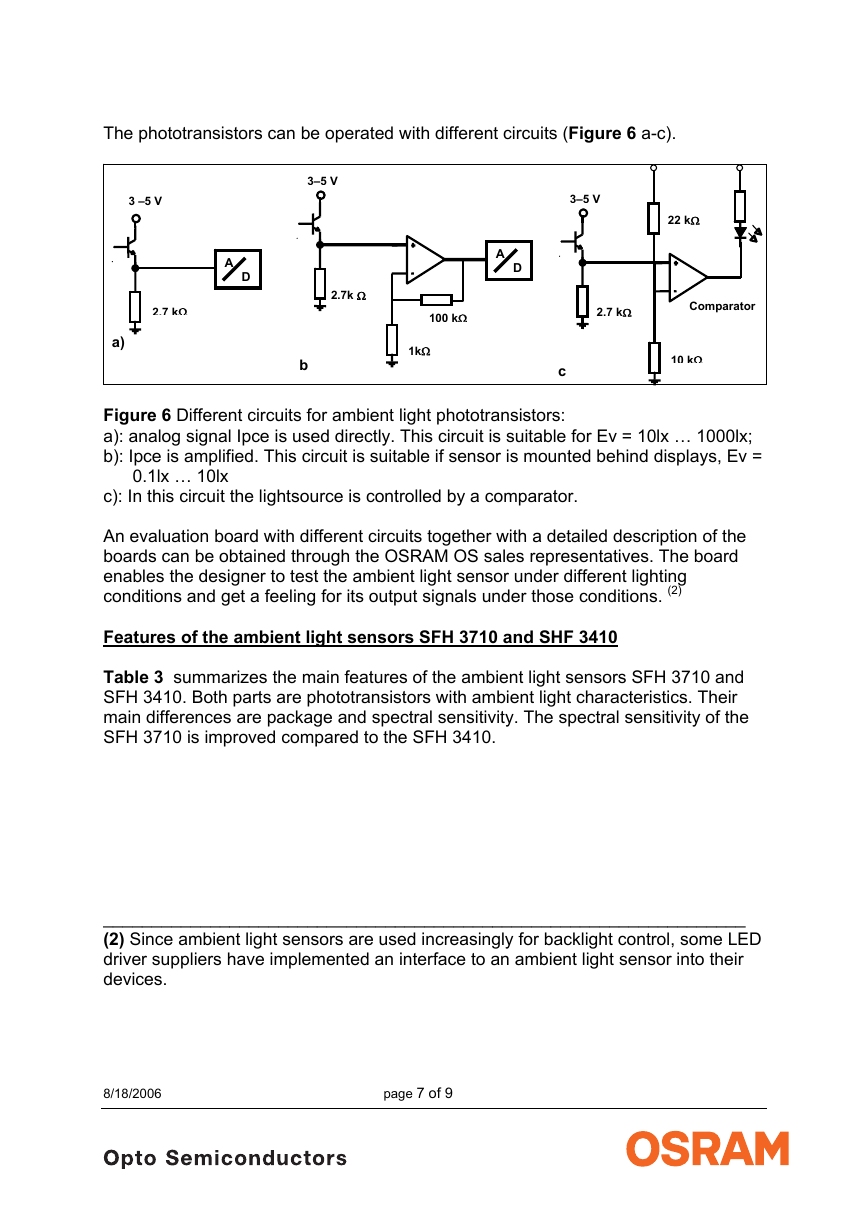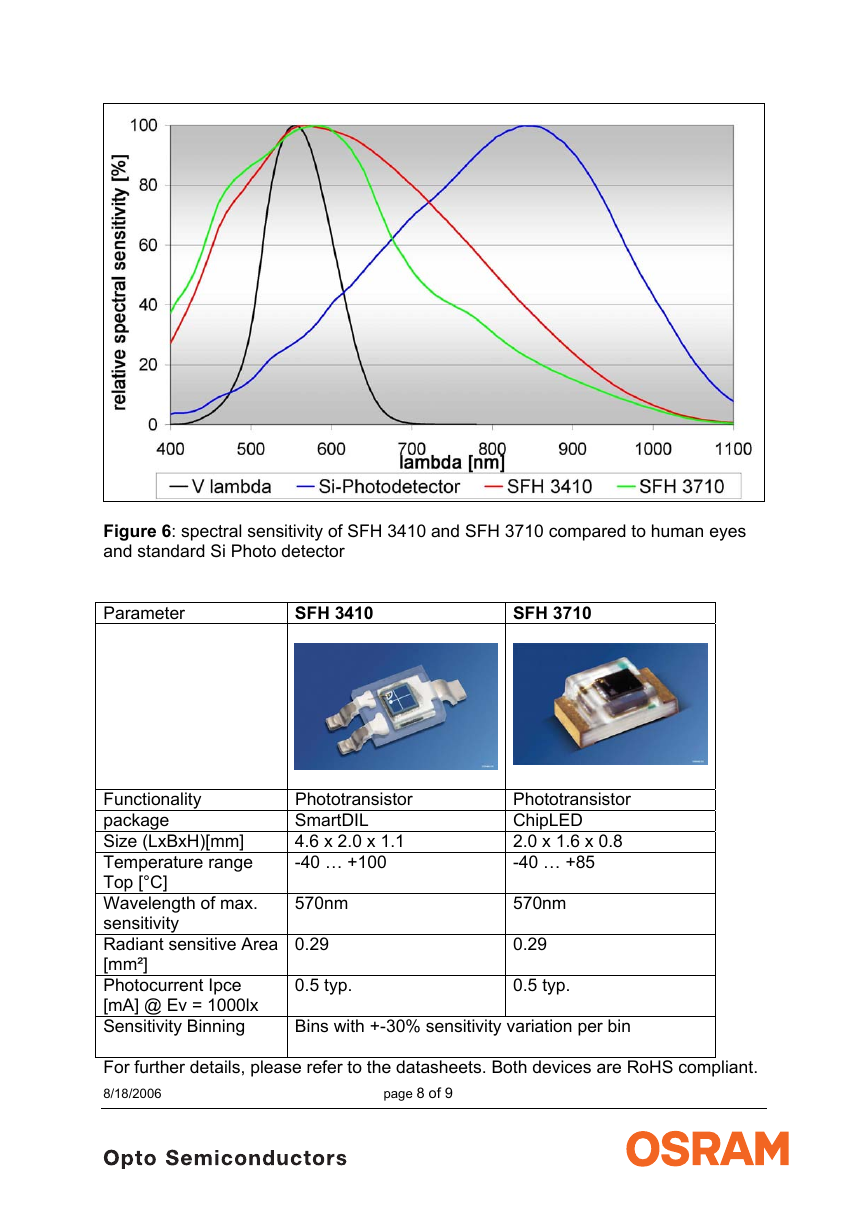Ambient Light Sensors SFH3410, SFH3710
Application Note
Abstract
This application note describes the ambient light sensors SFH 3710 and SFH 3410.
Both sensors are photo transistors which are especially adapted to the human eye.
Introduction
Osram OS has developed the SFH 3710 and SFH 3410 as low cost ambient light
sensors. Both devices are Silicon Phototransistors in small and flat SMT packages.
Applications for ambient light sensors
Ambient light sensors are designed to detect brightness in the same way as human
eyes do. They are used wherever the settings of a system have to be adjusted to the
ambient light conditions as perceived by humans:
• Saving battery power
These sensors provide low cost power saving solutions for hand-held
electronic devices such as PDAs, mobile phones and notebook PCs.
Nearly all LCD displays and keypads have backlighting. Studies have shown
that backlighting is only required about 40% of the time. If you have a way to
automatically adjust (auto dimming) the backlighting to be on only when you
need it you can have considerable power savings. This is welcome news for
battery powered devices.
• Automatic dimming of flat panel displays such as LCD screens to maintain the
same display appearance under all lighting conditions from twilight to bright
sunlight.
• Automatic dimming of instruments in automobiles to ensure reliable visibility
under all circumstances
Basic facts about ambient light sensing
Brightness
Brightness is a term that describes how intense a light source is perceived by the
human eye. Brightness is measured in the units called “LUX”.
Light sources with the same LUX level appear at the same brightness to the human
eye. Tab. 1.0 below shows the brightness (LUX measurement) of some everyday
light sources.
8/18/2006
page 1 of 9
�
Light source
candle (1m(3 ft) distance)
street light
office desk lighting
overcast day
overcast sunny day
direct sunlight
Illuminance
[Lux]
1
20
750
3000
20 000
100 000
Tab. 1 Lux measurement of every day light sources.
Spectral Sensitivity.
Spectral Sensitivity relates to where on the light spectrum the sensor is most
effective. Standard silicon phototransistors have a spectral response ranging from
1100nm right down to 350nm with the peak sensitivity around 900nm. The new
OSRAM OS ambient light sensors have a spectral response ranging from 1100nm
right down to 350nm but with the peak sensitivity around 580nm. This peak is very
similar to the human eye spectral sensitivity. The graph in figure 1 shows the
spectral sensitivity of a silicon phototransistor, an ambient light sensor and the
human eye (V-lambda curve).
Figure 1 Spectral sensitivity of different detectors compared to the human eye (V
lambda).
8/18/2006
page 2 of 9
�
Ambient Light Sensors versus standard Silicon detectors.
Every light source emits both visible and IR light.
Different light sources can have similar visible brightness (LUX) but different IR
emissions. (Figure 2)
Figure 2 spectral emission of different light sources compared to the spectral
sensitivity of human eyes (V lambda)
Using silicon photo detectors that measure mostly IR emissions (peak sensitivity at
880nm) can give you a false reading as to what the real Ambient Visible conditions
are.
In other words, for light sources with a high contribution of IR light, the signal
received by a silicon detector would suggest a much brighter situation than our eyes
actually see.
Figure 3 shows the different signals a silicon detector yields for different light sources
compared to the signals that a “human eye like” detector would see. Hence using a
lighting controlled by such sensors will not resemble the optimum brightness as felt
by humans. To establish a more suitable dimming or lighting control, it is essential to
find a sensor which emulates human eyes as closely as possible.
8/18/2006
page 3 of 9
�
Figure 3 Signals received by a Si-Photo detector for different light sources at the
same brightness compared to a detector with perfect human eye characteristics
Because the IR portion of the spectral sensitivity of ambient light sensors is greatly
reduced compared to Si-Photo detectors (see Figure 1), they are less sensitive to
the effects of different lamps. Figure 4 shows the signals of an ambient light sensor
received from different lamps compared to the signals standard photo detector. The
errors that are made are greatly reduced.
8/18/2006
page 4 of 9
�
Figure 4 Signals received by a standard photo detector and an ambient light sensor
for different light sources.
Operation of the ambient light sensors SFH 3410 and SFH 3710(1)
Both, SFH 3410 and SFH 3710 are Silicon Phototransistors. Their output signal is an
analog photocurrent Ipce which is proportional to the incident light level. (Figure 5)
-----------------------------------------------------------------------------------------------------
8/18/2006
page 5 of 9
�
(1): SFH 3710 and SFH 3410 have similar electrical and optical characteristics. All
information in this paragraph is valid for both devices
Figure 5 Output signal Ipce of SFH 3410 and SFH 3710 versus Illuminance.
Due to manufacturing process different phototransistors will give different outputs for
the same illuminance. To account for this, OSRAM offers the designer a choice of
binning options. Table 2 gives a summary of the binning options for the SFH 3410
and SFH 3710
SFH 3410
Ipce @ 20lx [µA]
3.2 … 6.3
5 … 10
8 … 16
12.5 … 25
SFH 3410-1
SFH 3410-2
SFH 3410-3
SFH 3410-4
Table 2 Sensitivity binning for SFH 3410 and SFH 3710
SFH 3710-2
SFH 3710-3
SFH 3710-4
SFH 3710
Ipce [µA] @
Ee =10µW/cm²,
λ =560nm
2.5 … 5
4 … 8
6.3 … 12.5
8/18/2006
page 6 of 9
�
The phototransistors can be operated with different circuits (Figure 6 a-c).
3 –5 V
3–5 V
3–5 V
22 kΩ
A
D
A
D
2.7 kΩ
a)
2.7k Ω
b
100 kΩ
1kΩ
2.7 kΩ
Comparator
c
10 kΩ
Figure 6 Different circuits for ambient light phototransistors:
a): analog signal Ipce is used directly. This circuit is suitable for Ev = 10lx … 1000lx;
b): Ipce is amplified. This circuit is suitable if sensor is mounted behind displays, Ev =
0.1lx … 10lx
c): In this circuit the lightsource is controlled by a comparator.
An evaluation board with different circuits together with a detailed description of the
boards can be obtained through the OSRAM OS sales representatives. The board
enables the designer to test the ambient light sensor under different lighting
conditions and get a feeling for its output signals under those conditions. (2)
Features of the ambient light sensors SFH 3710 and SHF 3410
Table 3 summarizes the main features of the ambient light sensors SFH 3710 and
SFH 3410. Both parts are phototransistors with ambient light characteristics. Their
main differences are package and spectral sensitivity. The spectral sensitivity of the
SFH 3710 is improved compared to the SFH 3410.
__________________________________________________________________
(2) Since ambient light sensors are used increasingly for backlight control, some LED
driver suppliers have implemented an interface to an ambient light sensor into their
devices.
8/18/2006
page 7 of 9
�
Figure 6: spectral sensitivity of SFH 3410 and SFH 3710 compared to human eyes
and standard Si Photo detector
Parameter
SFH 3710
SFH 3410
Phototransistor
SmartDIL
4.6 x 2.0 x 1.1
-40 … +100
570nm
0.29
Phototransistor
ChipLED
2.0 x 1.6 x 0.8
-40 … +85
Functionality
package
Size (LxBxH)[mm]
Temperature range
Top [°C]
Wavelength of max.
sensitivity
Radiant sensitive Area
[mm²]
Photocurrent Ipce
[mA] @ Ev = 1000lx
Sensitivity Binning
For further details, please refer to the datasheets. Both devices are RoHS compliant.
8/18/2006
Bins with +-30% sensitivity variation per bin
0.5 typ.
page 8 of 9
570nm
0.29
0.5 typ.
�


